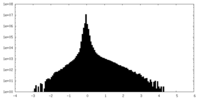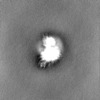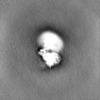[English] 日本語
 Yorodumi
Yorodumi- EMDB-43652: Kappa opioid receptor:Galphai protein in complex with inverse ago... -
+ Open data
Open data
- Basic information
Basic information
| Entry |  | |||||||||
|---|---|---|---|---|---|---|---|---|---|---|
| Title | Kappa opioid receptor:Galphai protein in complex with inverse agonist norBNI, Original map G protein | |||||||||
 Map data Map data | ||||||||||
 Sample Sample |
| |||||||||
 Keywords Keywords | G protein coupled receptor / Opioid receptor / MEMBRANE PROTEIN | |||||||||
| Biological species |  Homo sapiens (human) Homo sapiens (human) | |||||||||
| Method | single particle reconstruction / cryo EM / Resolution: 3.3 Å | |||||||||
 Authors Authors | Gati C / Motiwala Z / Tyson AS / Styrpejko D / Han GW / Khan S / Ramos-Gonzalez N / Shenvi R / Majumdar S | |||||||||
| Funding support |  United States, 2 items United States, 2 items
| |||||||||
 Citation Citation |  Journal: Nat Chem Biol / Year: 2025 Journal: Nat Chem Biol / Year: 2025Title: Molecular mechanisms of inverse agonism via κ-opioid receptor-G protein complexes. Authors: Aaliyah S Tyson / Saif Khan / Zenia Motiwala / Gye Won Han / Zixin Zhang / Mohsen Ranjbar / Daniel Styrpejko / Nokomis Ramos-Gonzalez / Stone Woo / Kelly Villers / Delainey Landaker / Terry ...Authors: Aaliyah S Tyson / Saif Khan / Zenia Motiwala / Gye Won Han / Zixin Zhang / Mohsen Ranjbar / Daniel Styrpejko / Nokomis Ramos-Gonzalez / Stone Woo / Kelly Villers / Delainey Landaker / Terry Kenakin / Ryan Shenvi / Susruta Majumdar / Cornelius Gati /  Abstract: Opioid receptors, a subfamily of G protein-coupled receptors (GPCRs), are key therapeutic targets. In the canonical GPCR activation model, agonist binding is required for receptor-G protein complex ...Opioid receptors, a subfamily of G protein-coupled receptors (GPCRs), are key therapeutic targets. In the canonical GPCR activation model, agonist binding is required for receptor-G protein complex formation, while antagonists prevent G protein coupling. However, many GPCRs exhibit basal activity, allowing G protein association without an agonist. The pharmacological impact of agonist-free receptor-G protein complexes is poorly understood. Here we present biochemical evidence that certain κ-opioid receptor (KOR) inverse agonists can act via KOR-G protein complexes. To investigate this phenomenon, we determined cryo-EM structures of KOR-G protein complexes with three inverse agonists: JDTic, norBNI and GB18, corresponding to structures of inverse agonist-bound GPCR-G protein complexes. Remarkably, the orthosteric binding pocket resembles the G protein-free 'inactive' receptor conformation, while the receptor remains coupled to the G protein. In summary, our work challenges the canonical model of receptor antagonism and offers crucial insights into GPCR pharmacology. | |||||||||
| History |
|
- Structure visualization
Structure visualization
| Supplemental images |
|---|
- Downloads & links
Downloads & links
-EMDB archive
| Map data |  emd_43652.map.gz emd_43652.map.gz | 32.4 MB |  EMDB map data format EMDB map data format | |
|---|---|---|---|---|
| Header (meta data) |  emd-43652-v30.xml emd-43652-v30.xml emd-43652.xml emd-43652.xml | 20.1 KB 20.1 KB | Display Display |  EMDB header EMDB header |
| Images |  emd_43652.png emd_43652.png | 71.5 KB | ||
| Filedesc metadata |  emd-43652.cif.gz emd-43652.cif.gz | 4.8 KB | ||
| Others |  emd_43652_additional_1.map.gz emd_43652_additional_1.map.gz emd_43652_half_map_1.map.gz emd_43652_half_map_1.map.gz emd_43652_half_map_2.map.gz emd_43652_half_map_2.map.gz | 59.5 MB 59.4 MB 59.4 MB | ||
| Archive directory |  http://ftp.pdbj.org/pub/emdb/structures/EMD-43652 http://ftp.pdbj.org/pub/emdb/structures/EMD-43652 ftp://ftp.pdbj.org/pub/emdb/structures/EMD-43652 ftp://ftp.pdbj.org/pub/emdb/structures/EMD-43652 | HTTPS FTP |
-Validation report
| Summary document |  emd_43652_validation.pdf.gz emd_43652_validation.pdf.gz | 766.5 KB | Display |  EMDB validaton report EMDB validaton report |
|---|---|---|---|---|
| Full document |  emd_43652_full_validation.pdf.gz emd_43652_full_validation.pdf.gz | 766.1 KB | Display | |
| Data in XML |  emd_43652_validation.xml.gz emd_43652_validation.xml.gz | 12.2 KB | Display | |
| Data in CIF |  emd_43652_validation.cif.gz emd_43652_validation.cif.gz | 14.3 KB | Display | |
| Arichive directory |  https://ftp.pdbj.org/pub/emdb/validation_reports/EMD-43652 https://ftp.pdbj.org/pub/emdb/validation_reports/EMD-43652 ftp://ftp.pdbj.org/pub/emdb/validation_reports/EMD-43652 ftp://ftp.pdbj.org/pub/emdb/validation_reports/EMD-43652 | HTTPS FTP |
-Related structure data
- Links
Links
| EMDB pages |  EMDB (EBI/PDBe) / EMDB (EBI/PDBe) /  EMDataResource EMDataResource |
|---|
- Map
Map
| File |  Download / File: emd_43652.map.gz / Format: CCP4 / Size: 64 MB / Type: IMAGE STORED AS FLOATING POINT NUMBER (4 BYTES) Download / File: emd_43652.map.gz / Format: CCP4 / Size: 64 MB / Type: IMAGE STORED AS FLOATING POINT NUMBER (4 BYTES) | ||||||||||||||||||||||||||||||||||||
|---|---|---|---|---|---|---|---|---|---|---|---|---|---|---|---|---|---|---|---|---|---|---|---|---|---|---|---|---|---|---|---|---|---|---|---|---|---|
| Projections & slices | Image control
Images are generated by Spider. | ||||||||||||||||||||||||||||||||||||
| Voxel size | X=Y=Z: 1.294 Å | ||||||||||||||||||||||||||||||||||||
| Density |
| ||||||||||||||||||||||||||||||||||||
| Symmetry | Space group: 1 | ||||||||||||||||||||||||||||||||||||
| Details | EMDB XML:
|
-Supplemental data
-Additional map: #1
| File | emd_43652_additional_1.map | ||||||||||||
|---|---|---|---|---|---|---|---|---|---|---|---|---|---|
| Projections & Slices |
| ||||||||||||
| Density Histograms |
-Half map: #1
| File | emd_43652_half_map_1.map | ||||||||||||
|---|---|---|---|---|---|---|---|---|---|---|---|---|---|
| Projections & Slices |
| ||||||||||||
| Density Histograms |
-Half map: #2
| File | emd_43652_half_map_2.map | ||||||||||||
|---|---|---|---|---|---|---|---|---|---|---|---|---|---|
| Projections & Slices |
| ||||||||||||
| Density Histograms |
- Sample components
Sample components
-Entire : Kappa opioid receptor in complex with heterotrimeric G protein (G...
| Entire | Name: Kappa opioid receptor in complex with heterotrimeric G protein (Gai/b/g) and inverse agonist norBNI |
|---|---|
| Components |
|
-Supramolecule #1: Kappa opioid receptor in complex with heterotrimeric G protein (G...
| Supramolecule | Name: Kappa opioid receptor in complex with heterotrimeric G protein (Gai/b/g) and inverse agonist norBNI type: complex / ID: 1 / Parent: 0 / Macromolecule list: #1-#5 |
|---|---|
| Source (natural) | Organism:  Homo sapiens (human) Homo sapiens (human) |
| Molecular weight | Theoretical: 130 KDa |
-Experimental details
-Structure determination
| Method | cryo EM |
|---|---|
 Processing Processing | single particle reconstruction |
| Aggregation state | particle |
- Sample preparation
Sample preparation
| Concentration | 18 mg/mL | ||||||||||||
|---|---|---|---|---|---|---|---|---|---|---|---|---|---|
| Buffer | pH: 7.5 Component:
| ||||||||||||
| Grid | Model: Quantifoil R1.2/1.3 / Material: GOLD / Mesh: 200 / Support film - Material: GOLD / Support film - topology: HOLEY ARRAY | ||||||||||||
| Vitrification | Cryogen name: ETHANE / Chamber humidity: 90 % / Chamber temperature: 298 K / Instrument: FEI VITROBOT MARK IV |
- Electron microscopy
Electron microscopy
| Microscope | FEI TITAN KRIOS |
|---|---|
| Specialist optics | Energy filter - Name: GIF Bioquantum / Energy filter - Slit width: 20 eV |
| Image recording | Film or detector model: GATAN K3 BIOQUANTUM (6k x 4k) / Number grids imaged: 1 / Average electron dose: 60.0 e/Å2 |
| Electron beam | Acceleration voltage: 300 kV / Electron source:  FIELD EMISSION GUN FIELD EMISSION GUN |
| Electron optics | C2 aperture diameter: 50.0 µm / Calibrated magnification: 105000 / Illumination mode: FLOOD BEAM / Imaging mode: BRIGHT FIELD / Cs: 2.7 mm / Nominal defocus max: -25.0 µm / Nominal defocus min: -15.0 µm |
| Sample stage | Specimen holder model: FEI TITAN KRIOS AUTOGRID HOLDER / Cooling holder cryogen: NITROGEN |
| Experimental equipment |  Model: Titan Krios / Image courtesy: FEI Company |
 Movie
Movie Controller
Controller

















 Z (Sec.)
Z (Sec.) Y (Row.)
Y (Row.) X (Col.)
X (Col.)












































